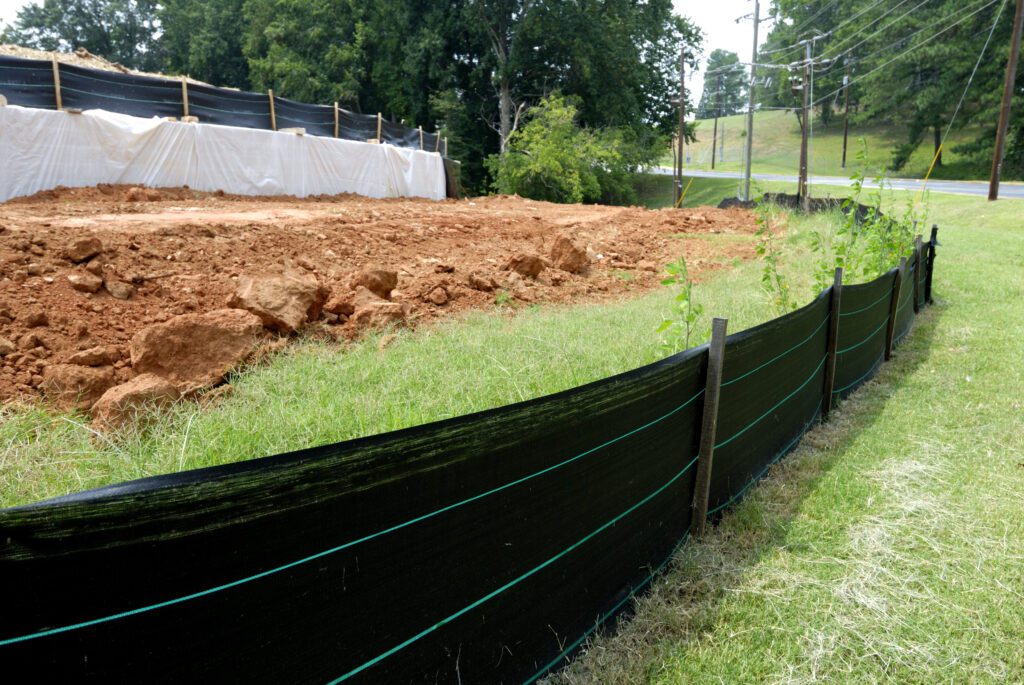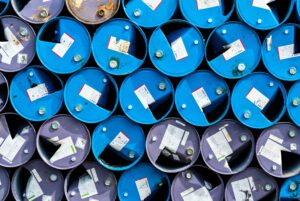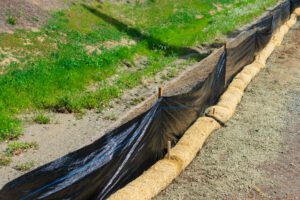The activity on construction sites is meant to shape the future as new buildings emerge and older buildings are improved. As we move forward with new projects, Erosion and Sediment Control is a vital aspect of protecting the environment and are crucial to a sustainable future.
Erosion and Sediment Controls (ESCs) can help minimize the negative impacts that construction activities may have on soil erosion and water quality. Here, we tackle some of the key aspects of ESCs and dive into strategies you can use to sustainably construct the future.
Understanding Your Construction Site
There are many options for ESCs depending on the type of site you have, but there is no “one size fits all” solution. Before you even break ground on your project, it is imperative that you conduct a thorough inspection of the site.
You’ll want to look specifically at places where sediment can leave the site, paying special attention to sites adjacent to developed areas. Inspecting the discharge locations is crucial. Make sure you understand what the exiting flow will do. Will the flow spread out and dissipate? Or will it remain concentrated?
Keep in mind that problems can especially arise on larger sites, sites with large disturbed areas, and sites with steep slopes and/or steep ditches and channels.
With information from your inspection, you’ll want to plan the location and type of practices you’ll use for responsible pollution prevention. Be sure to check if your local municipality has specific requirements in their drainage or stormwater manual as well.
Erosion and Sediment Control Options
Depending on the type of site you have and the factors at play, there are different options for how you can responsibly manage runoff.
Perimeter Controls: Sheet Flow
Silt Fence
Silt fences are generally appropriate on slopes up to 110 feet in length and for a maximum drainage area of 0.1 acres. For areas up to 0.2 acres, you may also choose to use a wire-reinforced silt fence.
For your silt fence to be effective, you’ll need to make sure you install it properly by trenching it in and installing posts on the downslope side. Do not install silt fences in ditches or channels or in dips with large drainage areas.
You’ll also need to regularly maintain and inspect your silt fence. Make sure it is catching all of the flow (including not allowing flow to bypass around the ends), remains standing upright, and does not have sediment buildup that inhibits its function. As soon as you notice potential issues, correct them to keep your silt fence in working order.
Other Sheet Flow Options
For areas larger than 0.2 acres, you may choose to use other controls. Here are some options and tips for using them:
- Fiber logs — The proper spacing of these depends on the velocity of the flow.
- Rock berms — Clean #57 stones work best.
- Grass filter strips — The minimum recommended width for these is generally 1/3 the width of the upslope disturbed area.
Other products are also available, and if you use them you will need to be sure to follow the manufacturer’s specifications and include information about them in your ESC plan or Stormwater Pollution Prevention Plan (SWPPP).
Perimeter Controls: Concentrated Flows
Rock Checks and Sediment Traps
For larger areas, you may need to use rock berms or sediment traps to help dissipate the flow velocity. These may be rock ditch checks that use larger rocks to slow the flow or rock berms that use smaller rocks to promote sediment settling.
It’s important to monitor your rock checks and sediment traps, especially during rain events. You’ll want to make sure the flow isn’t bypassing the control and that the rock check or sediment trap in place is sufficient enough to prevent blowouts.
Inlet Protection
Inlet protection is a method used to filter sediment out of water before it enters a storm drain inlet. You can use a variety of methods to achieve this, including rock berms and bags, fiber logs, inlet frame filters, and silt fences.
No matter what method you use, your inlet protection must be functional and maintained. It should also not cause flooding.
Ditches and Channels
If there are ditches or channels on your site, make sure vegetation present is stable and there is no erosion along the banks. If you have an erosion control blanket or turf reinforcement mat in place, make sure it is adequately staked and not dislodged. You’ll also want to make sure there are no blockages or signs of pollutants within the channel.
Sediment Traps and Ponds
Sediment traps and ponds can also be used to intercept runoff from a site. These controls allow sediment to settle to the bottom of the pond or trap before the rest of the runoff is released. If you plan to use a sediment trap or pond at your construction site, install it as early as possible and seed and mulch it quickly so it is ready to function.
As with all other ESC practices, you will need to frequently inspect your traps and ponds to maintain them and to keep them functioning. Watch out for short circuiting, which occurs when the water is discharged before the sediment has a chance to settle out.
Dewatering
Dewatering is the removal of stormwater or groundwater from excavation pits or trenches created during construction. Water-filled excavations are unsafe for workers and prevent work from continuing, so it must be removed.
The water that is removed from these areas can be full of sediment and must be pumped to a dewatering structure before it is discharged off site. You can use a well-vegetated area if it can withstand the velocity of the discharged water. You can also use a sediment trap, a portable sediment tank, a straw bale/silt fence pit, or a commercial sediment filter bag.
Trackout Prevention at Construction Site Entrance/Exit
Sediment trackout on streets is one of the biggest sources of pollution complaints. You want to make sure the entrance to your site remains clean so that vehicles leaving don’t track out sediment. This is not only a location where large amounts of sediment can leave your site, but it can create a safety hazard as well.
Soil Stockpile Management
Responsibly storing your soil stockpiles is essential for not only preventing soil loss but also preventing pollution.
Your small soil piles should be covered with tarps. Large piles should be seeded and mulched. Use perimeter control measures, such as silt fences and fiber logs, around your soil stockpiles as well to prevent polluting runoff.
The placement of your piles is also important. Place them at the best upgradient location away from inlets and streams.
Pollution Prevention at Your Construction Site
While controlling sediment is crucial to the upkeep of your construction site and the environment surrounding your site, there may be other potential pollutants on your construction site. Make sure you have a plan to properly manage all materials that can contaminate stormwater runoff.
Material Storage Areas
Pay special attention to fuel areas, oil storage, and other chemical storage. Always keep pollutants away from the drainage system and keep them covered. If there are spills, clean them up quickly.
Concrete Washouts
Make sure your concrete washouts are constructed and maintained appropriately. Details about your concrete washouts must be noted in your ESC plan and/or SWPPP. You should also have a sign designating its location on your site.
Your concrete washout should be leakproof and sited away from drains and waterways. In addition, make sure you have a rock pad leading to the washout and that the pad and washout are removed before the construction site is closed out.
And like with all other sediment flow preventions, inspect and maintain your concrete washouts regularly to make sure they are operating as they should.
Find Erosion and Sediment Control Solutions
Preventing erosion and controlling the discharge of sediment at your construction site is not just critical for the functionality of your site, it is necessary to responsibly protect the environment your company is building in. By employing effective ESC measures, your site can minimize its ecological footprint.
If you need help determining the best methods to use at your construction site, contact Tetra Tech’s Environmental, Health, and Safety experts at [email protected]. We can assist you in finding solutions that will help you build a more sustainable future.






